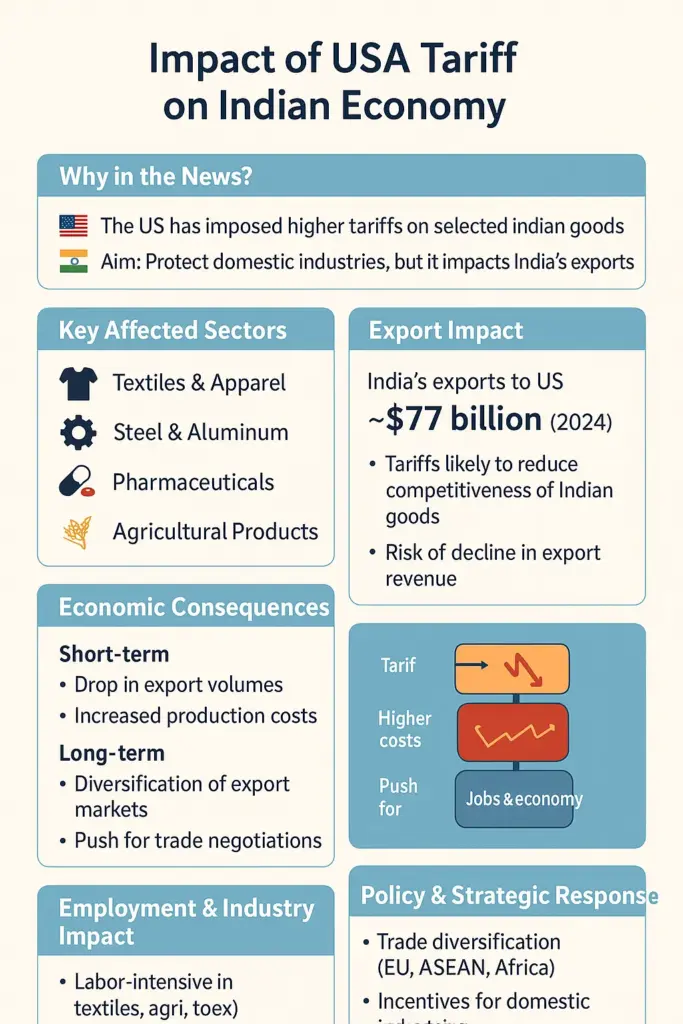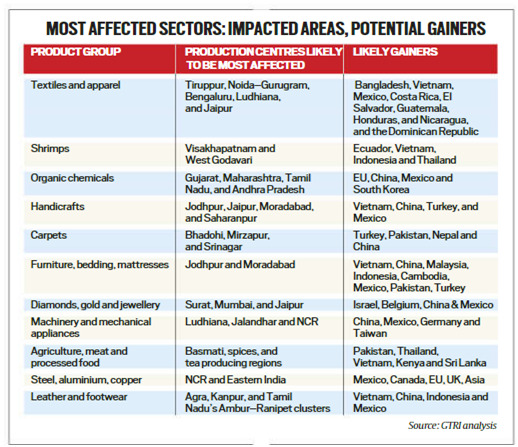August 27, 2025
Impact of USA Tariff on Indian Economy
Why in the News?
The U.S. government is set to implement an additional 25% tariff on Indian goods starting August 27, 2025, following President Donald Trump’s executive order.
- This comes on top of the existing 25% tariffs since August 7, making a total of 50% duty on many Indian exports.
- Tariffs are being imposed partly as a penalty for India’s continued import of Russian oil.
- India has described these sanctions as “unfair, unwarranted, and unreasonable.”
Key Points: Impact of USA Tariff on Indian Economy
Tariff Details:
- 50% effective tariff on $47-48 billion worth of Indian exports.
- Exemptions: Iron, steel, aluminum, passenger vehicles, copper products.
- Tariffs effective for U.S.-bound shipments after Aug 27, 2025.
Reactions:
- Indian Government: Pushing “Vocal for Local” to reduce reliance on U.S. markets.
- China: Called the U.S. a “bully” and expressed support for India.
- RBI: Promised support to adversely affected sectors.
- Exporters’ View: Expect major competitiveness loss against China, Vietnam, Philippines, etc.
Domestic Response:
- GST Council to meet (Sept 3–4, 2025) for rate cuts and rationalization to boost domestic consumption.
Impact of Tariffs on Indian Economy:
Export Sector Hit:
- Indian exports valued at approximately $47–48 billion, accounting for 55% of shipments to the U.S., encounter a 30–35% pricing disadvantage.
- Likely to hurt textiles, pharmaceuticals, IT hardware, machinery, and consumer goods.
Balance of Payments Stress:
- India’s trade surplus with the U.S. may shrink.
- Forex inflows could reduce, pressurizing rupee.
GDP Growth Impact:
- Exports being a growth driver, tariffs may slow down overall growth.
- Some sectors may face layoffs and reduced production.
Inflationary Concerns:
- U.S. tariffs may reduce India’s competitiveness → lower demand for Indian goods → domestic over-supply could depress prices in some sectors.
- But higher import substitution efforts may push domestic inflation in the medium term.
Options Before India & Steps needed:
Diplomatic Measures:
- Engage in bilateral negotiations with the U.S. to roll back or reduce tariffs.
- Explore options under WTO’s Dispute Settlement Body (though time-consuming).
- Use support from China and other affected countries to build pressure on U.S. in multilateral forums.
Economic/Trade Diversification:
- Reduce over-dependence on the U.S. market by boosting exports to EU, ASEAN, Middle East, Africa.
- Encourage South-South cooperation and expand trade with BRICS members.
Domestic Policy Response:
- GST rationalization to cut production costs.
- Provide export subsidies, credit support, and insurance to affected sectors.
- Expand PLI (Production Linked Incentive) schemes to make Indian products more competitive.
Strategic Shift:
- Boost domestic industries by advancing the ‘Self-Reliant India’ and ‘Support Local’ initiatives.
- Push for regional trade agreements (RCEP reconsideration, IPEF engagement, FTAs with UK & EU)
GIST OF DAILY ARTICLES THE HINDU/INDIAN EXPRESS/27 August 2025
August 27, 2025
Daily The Hindu Article Gist : 25 August 2025/ Jan Vishwas 2.0
August 25, 2025
Solved Paper UPSC MAINS -2025 GS PAPER-1 / Model Answer
August 23, 2025
UPSC MAINS 2025 GS PAPER 1 HELD ON 23 AUGUST 2025
August 23, 2025


